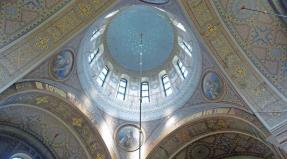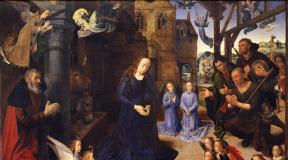Alexandrian Orthodox Church. History of the Alexandrian Orthodox Church
Translated from English by Marina Leontyeva
The Orthodox of Egypt greeted with joy the news of Patriarch Kirill's visit to the ancient Alexandrian Patriarchate. The head of the largest and most influential Orthodox Church in the world began his trip with a visit to the See of St. Mark the Apostle and will end it in Syria in Damascus. This message quickly spread among the parishioners, and soon preparations began in Alexandria and Cairo for this great spiritual event.
Patriarch Kirill together with Patriarch Theodore II celebrated the Divine Liturgy in cathedral Alexandria. Cairo priests under the leadership of Archimandrite Elias Habib came to Alexandria to take part in this historical event along with the Alexandrian believers.
It seems to me that there are two important reasons for such a joyful reaction and a festive atmosphere. First, the historically close ties between the two Patriarchates. Secondly, the significant authority of the Moscow Patriarch as an outstanding spiritual personality of the Orthodox world.
Over the past two decades, Russian Orthodox Church strengthened its spiritual role and its cooperation in the Middle East. The grandiose cathedral of St. Nicholas was erected in the United Arab Emirates, the resumption of activities in Jerusalem is noticeable, thanks to which the Christians of the Antioch Church receive material and spiritual support. Missionaries can be found in Africa today contributing to the efforts of the Alexandrian Patriarchate in this poor and often desolate part of the world.
Historically, we, the Alexandrians, are well aware of how the Russian Church helped in the restoration of the Orthodox Churches and the Patriarchal Library. The current Patriarch Theodore II of Alexandria was the governor of the Alexandrian Diocese in Moscow. He speaks fluent Russian, and sometimes even prays in Russian. He was present at the enthronement of Patriarch Kirill and performed with him his first post-enthronement Divine Liturgy in the Cathedral of Christ the Savior.
As further evidence of the close relationship, Patriarch Kirill presented bells cast in Russia specifically for the Patriarchal St. George Monastery in Cairo. This can be considered an indication of the prospect of further cooperation at the official and pastoral levels.
As a member of the Alexandrian Orthodox Church, I perceive the first visit of Patriarch Kirill to the Alexandrian Patriarchate as a continuation of cooperation and assistance of the Russian Church. The church in Egypt needs support in its programs and development. IN this moment the main challenges facing the Church are poverty and social problems. African missionaries need the support of the entire Christian world, help in preaching the Gospel and enlightening people who live on the poorest continent in difficult conditions with divine light.
On the spiritual plane, interest in the Russian patristic heritage is growing. Orthodox Christians in Central Asia today are working on the translation and study of the Russian holy fathers. The Church of the Holy Archangels in Egypt has published some translations of famous works of modern Russian fathers. The Arabic-speaking Orthodox believers are gradually becoming familiar with the works of the fathers Sergiy Bulgakov, Georgy Florovsky. I am convinced that the Russian Orthodox Church should propose and support activities for communication between Alexandrian and Russian believers, including introducing Orthodox Christians of the Middle East to Russian spiritual experience.
I believe that this visit will be a positive step towards fulfilling these expectations.
A brief history of the church
The Alexandrian Church is the second most important among the Orthodox churches. At present, it numbers about 250 thousand believers and is relatively small in comparison with other churches: the majority of Christians in Egypt belong to the Coptic Church - Monophysite, which is heretical from the point of view of Orthodoxy.
The Alexandrian Church, according to legend, was founded around 42 years old by the apostle and evangelist. Christianity in Alexandria was opposed by numerous pagan cults. Since 451, the church has become a patriarchy, the third in importance after the Roman See and Constantinople. She gave the Christian world many great names: saints and Cyril of Alexandria, the founders of theology, Clement of Alexandria and his successor Origen. Christian Egypt is the birthplace of monasticism, here lived the Monks and Pachomius the Great, the famous abvas (mentors of the monks) Paisius, and the Great Ones.
At the end of the 5th century, most of the Christians of Alexandria passed into the Monophysite heresy, and in the 7th century Alexandria was conquered by the Arabs, and the Orthodox Church fell into final decline. At the beginning of the 16th century, Alexandria was conquered by the Turks, and until the 19th century the Patriarchs of Alexandria were subject to those of Constantinople. Many of them lived in Istanbul for years and hardly ever appeared in Egypt. Relations between the Church of Alexandria and Russia began to develop in the 16th century.
The situation of Christians in Egypt improved only in early XIX century, during the reign of Muhammad Ali, who established religious freedom, but periodically religious persecutions are resumed in Egypt to this day.
The Alexandrian Patriarchate became fully independent in 1935.
Patriarch of Alexandria
The future patriarch Theodore II (in the world Nikolaos Choreftakis) was born on November 25, 1954 in the village of Kasteli on the island of Crete, graduated from the theological faculty of Thessaloniki University, studied art history at the University of Odessa. In 1973 he was tonsured a monk at the Agarath monastery in the city of Heraklion (Crete). In 1978 he was ordained a hieromonk, from 1985 to 1990 he was the representative of the Patriarch of Alexandria to the Patriarch of Moscow and All Russia (the courtyard of the Alexandrian Patriarchate was at that time in Odessa). In 1990, the future patriarch was ordained a bishop, received the title of Bishop of Kirinsky, and was appointed exarch of the Alexandrian Orthodox Church in Athens. In 1997 he became Metropolitan of Cameroon, in 2002 - Metropolitan of Zimbabwe. After the death of Patriarch Peter VII in a plane crash in 2004, he was elected Patriarch of Alexandria.
Patriarch Theodore II of Alexandria was the only patriarch of the local churches who participated in the enthronement of Patriarch Kirill of Moscow and All Russia on February 1, 2009 in the Cathedral of Christ the Savior.
Egypt is one of the oldest civilizations in the world, mentioned more than once in Holy Scripture... Here, fleeing from cruel Herod, the Savior of the world spent his infancy with His Most Pure Mother and the named Elder Joseph.
The seeds of Christian faith were brought to the territory of the modern Arab Republic of Egypt by the holy apostle and evangelist Mark , who was martyred here in 68. According to legend, the Apostle Mark founded a catechetical icon in Alexandria, which later became a major scientific center.
In the II century, there was already an episcopal see in Egypt. The Alexandrian Church is considered the cradle of Christian monasticism. Here the monastic fathers Anthony, Pachomius and Macarius the Great, St. Mary of Egypt. The great teachers of the Alexandrian school worked here: Panten, Clement, Origen, Dionysius and Didim. In the struggle against heresies, the great lamps of the Alexandrian Church - Athanasius the Great and Cyril - became famous. In connection with the formation of the ecclesiastical-administrative structure, the Alexandrian Church took one of the leading places among the Orthodox Churches. Her primate among the patriarchs was given the second place after Constantinople. In the 5th century, a split occurred among the Christians of Egypt into Orthodox and Monophysites (Copts).
In the first half of the 7th century, Egypt was conquered by the Arabs and the Islamization of the population began in the country. Especially the massive conversion of Christians to Islam was observed in the 8th and 9th centuries. At the beginning of the XIII century, Catholicism spreads within Egypt. It was brought here by Western Christians in 1219 during a crusade. At the beginning of the 16th century, Egypt was conquered by the Ottoman Turks. From that time the Alexandrian Church until 1920 was in a difficult situation. She constantly experienced restrictions in her actions from the state authorities. The position of the Church was aggravated by the fact that during this period the hierarchy could not independently elect the Primate. The patriarchal throne was mainly ascended to the proteges of the Constantinople Church.
The most famous are the Alexandrian patriarchs: Meletius Pigas (1588-1801), Hierotheos I (1818-1845) and Hierotheos II (1847-1858), who led their small flock in difficult times. The Alexandrian Orthodox Church is governed by the Patriarch, whose residence is in Alexandria. Under the Patriarch, there is a Holy Synod consisting of 14 ruling bishops. Within Egypt, the Alexandrian Patriarchate consists of 5 dioceses. The congregation of the Church at the end of the 20th century numbered 30,000 believers, united in 55 parishes. The Church has 3 monasteries, the Patriarchal Library (founded in 1952), the Institute for Oriental Studies (founded in 1952), the Higher Spiritual and Pedagogical Seminary (since 1934). The official printed organ is the Pantenos magazine and the periodical Foros Ekklesistikos.
Outside Egypt, the Alexanrian Church extends its jurisdiction to the African continent, where it has 9 dioceses. In these dioceses, including those of Egypt, the flock of the Church, as of 1982, was 350,000 believers, who were cared for by 13 metropolitans. The dioceses were in charge of 176 churches. The Alexandrian Orthodox Church has a courtyard on the territory of Ukraine, which is located in Odessa. It consists of the residence of the abbot of the courtyard and the church in honor of the Holy Trinity. The courtyard was founded in 1955 and is a living link between the Russian and Aleksanrian Orthodox Churches. 116th Patriarch of Alexandria is currently, since 2004, is Theodore (Choreftakis ), Most Blessed, Most Divine and Holy Father and the Chief Pastor, Pope and Patriarch of the Great City of Alexandria, Libya, Pentapolis, Ethiopia, all Egypt and all Africa, Father of the Fathers, Shepherd of Shepherds, Bishop of Bishops, Thirteenth Apostle, Judge of the Universe.
ALEXANDRIAN ORTHODOX CHURCH (APC; Alexandrian Patriarchate), Orthodox Local church, whose jurisdiction extends to Egypt and Africa. Named after the capital of Hellenistic and Roman Egypt - Alexandria. In ancient times, it occupied a dominant place among the Orthodox churches of the East, but from the 2nd Ecumenical Council (381) it ceded it to the Constantinople Orthodox Church. According to the decrees of the first two Ecumenical Councils (I Ecu. 6, II Ecu. 2), the power of the Bishop of Alexandria extended "to the whole of Egypt."
History of the APTs. Although the spread of Christianity in Alexandria, many apocryphal and ancient literary monuments were associated with the names of the apostles Luke or Barnabas (out of 70), the church tradition attributes the foundation of the AOC to the evangelist and the Apostle Mark (Eusebius. Pentapole around 39-49. In Alexandria, Mark suffered a martyr's death and was buried in the church of Vukola (later the archbishops of Alexandria were buried here).
In the 2-3 centuries the Didascals (Christian teachers) of the APTs Panten, Clement of Alexandria, Origen, who laid the foundations of the Alexandrian school of theology, polemicized with the Gnostics, pagans and Jews. In 202-312, the Christians of Egypt were persecuted by the civil authorities. At the beginning of the 4th century, a Melitian schism arose, condemned by the Council of Alexandria in 306, as well as Arianism, condemned on the 1st Ecumenical Council (Nicaea, 325) thanks to the efforts of Saint Alexander of Alexandria, Hosea of \u200b\u200bKorduba and Saint Athanasius the Great.
Saint Cyril of Alexandria (patriarch in 412-444) actively fought against the Novatian schism in Alexandria and Nestorianism, having achieved the condemnation of the latter at the 3rd Ecumenical Council (city of Ephesus, 431). The speech of the Patriarch of Alexandria Dioscoros in the middle of the 5th century on the side of Monophysitism, condemned at the 4th Ecumenical Council (city of Chalcedon, 451), led to a split in the AOC into Chalcedonites (the Monophysites began to call them Melkites, that is, "royal" and the help of the emperor of power) and the Monophysites [named Copts (from the Greek Αιγ? πτιοι - Egyptians)] who formed the Coptic Church. In the 7th century, the AOC experienced the heresy of Monothelism, which was opposed in Alexandria by the Monk Maxim the Confessor.
It was in the Egyptian deserts that Christian monasticism was formed, the founders of which are considered the anchorite (hermit) Paul of Thebes (mid-3rd century) and the Monk Anthony the Great (3-4 centuries). St. Athanasius the Great hid with the Monk Anthony during the persecution. The most famous Egyptian monasteries by the middle of the 4th century were Nitria, founded by the Monk Ammon (Ammun) of Egypt, and the Skete, founded by the Monk Macarius the Great. The beginning of the cenobitic monasteries (kinovia) was laid at the beginning of the 4th century by the Monk Pachomius the Great. Some monasteries were home to up to 2 thousand monastics. Monasteries played an important role not only in religious life APC, but also in the political life of Byzantium. By the time of the Persian invasion of Egypt (619), there were about 600 monasteries in the vicinity of Alexandria.
The heyday of the APTs ended with the transition of Egypt to the rule of the Caliphate in the middle of the 7th century. Christians were numbered among the dhimmian class, who retained a certain freedom of faith and autonomy. At the same time, Christians (mainly Melkites, since the Copts were perceived by Muslims as enemies of Byzantium) were repeatedly persecuted, Islamized and Arabized, especially during the reign of the caliphs al-Mutawakkil (847-861), al-Hakim (996-1020), and then under the Mamluks (13-16 centuries). The crusades of the 11-13 centuries aggravated the plight of Egyptian Christians, who were oppressed by Muslims (for example, under Sultan Salah ad-din Yusuf ibn Ayyub in the 12th century), and crusaders, for whom Eastern Christians were schismatics. During the Ottoman period (from 1517), the external position of the Egyptian Christians was relatively tolerant.
In the 16th century, contacts between the AOC and Russia began (in 1523, 1556, delegations of the AOC visited Russia to collect donations, in 1593 Patriarch Meletius Pigas participated in the Constantinople Cathedral, discussing the establishment of a patriarchate in Russia). In the AOC in the 1830s-40s, there were about 2-5 thousand people (Greeks and Arabs), while the Copts-Monophysites - about 150-160 thousand people. In the 16th and early 19th centuries, there were 8 churches and 2 monasteries in the entire AOC. All the patriarchs were greek origin... In 1834, the APTs restored contacts with Russia, receiving significant sums from the Russian Empire and private donors. In 1855, the Alexandria courtyard was established in Russia.
The British protectorate over Egypt eased the position of Christians. By the beginning of the 20th century, there were already about 100 thousand people in the AOC (63 thousand Greeks, the rest of the Arabs of Syrian and Lebanese origin).
The current position of the APC... The Primate of the AOC bears the title “Pope and Patriarch of Alexandria and All Africa”. The APC includes 1 archdiocese, 14 metropolises and 4 bishops located in Egypt, South Africa, Congo, Ethiopia, Sudan, Uganda, Kenya, Tanzania. There are monasteries of St. Sava the Sanctified in Alexandria (founded in 320), St. Nicholas in Cairo (10th century). The APC has more than 400 parishes, about 300 priests, and more than 1 million members. APC is a member of the World Council of Churches, has 2 metochions in Athens, a representative office in Cyprus, a metochion in Moscow (headed by patriarchal exarch in Russia).
Source: Porfiry (Assumption), Bishop of the Alexandrian Patriarchate: Sat. materials, research and notes relating to the history of the Alexandrian Patriarchate. SPb., 1898.Vol. 1-2.
Lit .: [Matveevsky P.]. Essay on the history of the Alexandrian church from the time of the Chalcedon cathedral // Christian reading. 1856. Book. 1; Lolly (Yuryevsky), Archbishop of Alexandria and Egypt // Theological Works. 1978. Sat. 18. S. 136-179; Bagnall R.S. Egypt in the late antiquity. Princeton, 1993; Haas Ch. Alexandria in late antiquity: topography and social conflict. Balt .; L., 1997; Lebedev A.P. Historical sketches of the state of the Byzantine-Eastern Church from the end of the 11th to the middle of the 15th century. SPb., 1998; Alexandrian Orthodox Church // Orthodox encyclopedia... M., 2000.Vol. 1.
And others) laid the foundations of the Alexandrian school of theology, which became one of the most important theological centers of the Christian world.
During the first three centuries, a large number of temples and introduced its own rite of the liturgy - the liturgy of the Apostle Mark (Alexandrian).
In the III century, monasticism appeared in the Alexandrian church thanks to the activities of Anthony the Great. It spread to Egypt. By the end of the 4th century, Thebais and Nitria became its main centers. Subsequently, the experience of monastic life spread to the territories of Palestine, Syria and other countries.
The official and liturgical language of the Alexandrian Church was Greek. Most of the Alexandrian theologians also used Greek.
A significant event dates back to the reign of St. Athanasius of Alexandria: c. In 330, the Alexandrian Church extended its jurisdiction outside the Roman Empire - to Axum, where he was made bishop of St. Frumentius. Later, Christianity spread to other areas adjacent to Egypt, in particular, in Nubia and Arabia. The autonomous Churches that emerged, Ethiopian and Arabian, were canonically dependent on the throne of the Apostle Mark. It is possible that in the 6th century the regions of North-West Africa (Carthage Church) and Southern Spain, which were annexed to Byzantium under Emperor Justinian I, were transferred to the jurisdiction of the Alexandrian Patriarchate.
The division of the Alexandrian church after the Chalcedonian cathedral
The Alexandrian Church, which had its own theological school, at various times headed by the great Fathers of the Church, became a consistent supporter of the Myafisite Christology, which allowed her to defend the doctrine of the Church from Nestorian Diophysitism that arose in the Antiochian theological school. The refusal of the Alexandrian patriarch Dioscorus I (444-451) to recognize the Diophysite teaching of Pope Leo in 451 led to the convening of the Council of Chalcedon, where, at the request of the papal legates, Dioscorus was condemned and deposed. The deposition of Patriarch Dioscorus beheaded the Alexandrian delegation, however, it became a formal reason for the refusal of the Alexandrians to sign under the council's creeds. With the serious opposition of the Alexandrian church to the Chalcedonian cathedral, the patriarch-Chalcedonian Proterius was appointed imperial power in it. It was overthrown by the rebellious Alexandrians as soon as the imperial troops left the city. Proterius was replaced by the anti-Chalcedonian patriarch Timothy II Elur, which led to a conflict with the Constantinople authorities and gave rise to the split of the single Alexandrian church into two parallel churches: non-Chalcedonian and Chalcedonian. Since 538, dual patriarchal structures began to operate.
During the period of Arab rule and the Crusades
Under Caliph al-Mutawakkil (847-861), Christians had to endure severe persecution. Many churches were destroyed, it was forbidden to perform Divine services and the Sacraments.
By the 10th century, the Arabization of the Orthodox community of Egypt took place, it developed its own Arabic-language literature, the most prominent representatives which was the Patriarch Eutychios II and the historian of the X-XI centuries Yahya of Antioch, who spent the first half of his life in Egypt. The ethnic identity of the Egyptian Melkites was very blurred, but it is noticeable that they did not identify themselves either with the Byzantine Romans, much less with the Arabs. The common self-names of this community were the terms “Melkite Christians”, “Alexandrian Melkites”, etc., they did not know any more specific ethnic identification. Most of the Alexandrian Patriarchs of the VIII - early XI centuries came from the lands that were in the possession of the Caliphate, and were weakly associated with the Greco-Byzantine culture.
From the 11th century, a reverse wave of Hellenization of the Alexandrian Church began, and its ties with Byzantium were strengthened. Patriarchs, apparently of Greek origin, often visited Constantinople, wrote their treatises and sermons in greek (like Cyril II at the turn of the XI-XII centuries).
The severe decline that the Alexandrian Church underwent under Muslim domination led to the extreme limitation of historical sources that allow us to judge her inner life, social structure, etc. It is known that the number of Orthodox Christians in Egypt was extremely insignificant and was constantly decreasing. From 300 thousand people at the time of the Arab. conquest (about 5% of the total number of Egyptian Christians), the Melkite community decreased to 90-100 thousand by the beginning of the XIII century and to several thousand by the beginning of the Ottoman era.
Many of the Alexandrian Patriarchs of the 13th-14th centuries came from a Greek environment, lived in Constantinople for many years and hardly appeared in Egypt, but actively participated in the church life of Byzantium.
In 1439, the representative of the Pope of Alexandria, Philotheus, signed the Union of Florence (Ferraro-Florence Cathedral).
During Turkish domination
In 1517, Egypt became one of the provinces of the Ottoman Empire. The residence of the Patriarch of Alexandria was transferred to Constantinople, which contributed to the final consolidation of the Byzantine liturgy in the liturgical practice of the Alexandrian Church. The Alexandrian patriarchs during this period often also lived in Constantinople, taking an active part in local affairs, and visiting their pulpit. The Alexandrian Patriarchate actually lost its independence, falling into dependence on the Patriarch of Constantinople, who, together with his synod, appointed the Alexandrian patriarchs. The small flock was actually ruled by the patriarch himself, with whom there was sometimes another bishop. Since the majority of the Orthodox in Egypt were Greeks, the clergy of the Alexandrian Church was exclusively Greek.
In the Ottoman Empire, the Greek Alexandrian Church largely retained its significance due to the fact that the sultans endowed all the patriarchs under their control with the rights of ethnarchs (leaders of the nation). The Russian monk Arseny (Sukhanov), who visited Egypt in 1657, reported that "600 Orthodox Arabs and Hellenes live permanently in Cairo." All over Alexandria Orthodox Patriarchate in the 16th - early 19th centuries there were 8 churches - 4 in Cairo and one each in Alexandria (in the monastery of Saint Sava), Rosetta and Damietta - and 2 monasteries: the Monk Sava in Alexandria and the Great Martyr George in Cairo, where the patriarch's residence was located.
The Alexandrian Church had almost no income of its own in Egypt and therefore was constantly in a difficult financial situation and lived only thanks to the support of other Eastern patriarchs and the help of Orthodox states; first of all, Russia. Contacts of the Alexandrian Patriarchate with Russia and the Russian Church began in the time of Ivan IV the Terrible. The first of the Alexandrian popes to visit Russia was Patriarch Paisius, who took part in the council of 1666-1667, which deposed Patriarch Nikon.
In the 1830-1840s, observers estimated the size of the Orthodox community in Egypt at 2-5 thousand people, including foreign nationals living in the country. Most of the Orthodox lived in Cairo, Alexandria and Damietta, minor communities existed in Rosetta (Arab. Rashid) and Suez. The numerical growth of the Orthodox population and its growing prosperity could not but affect the position of the Alexandrian Patriarchate. Schools and charitable institutions began to open. In 1856, the Cathedral of the Annunciation in Alexandria, built at the expense of the community, was consecrated. By the middle of the 19th century, through the efforts of successful businessmen, the Greeks created public organizations - communities and charitable institutions. These communities were a completely new phenomenon in the social life of large cities, where for centuries the only legitimate public organization of the Orthodox population was the Alexandrian Orthodox Church, which, despite the lack of funds, tried to fulfill not only purely churchly, but also social functionsfor example, support the poor. With the emergence of communities led by energetic and socially active people, this traditional monopoly of the Church was challenged. Tensions between the Patriarchate and the communities began over rivalries over the leadership of charitable institutions. Then the communities began to apply for participation in the affairs of the Patriarchate itself. With the growth of the flock and the prosperity of the Alexandrian Church, its independence from the Patriarchate of Constantinople increased. Under Patriarch Hierotheos II, several episcopal sees were established, which made it possible to independently supply bishops and elect a patriarch. In 1866, Patriarch Nicanor was elected in Egypt, and not in Constantinople.
Under the weak heirs of Muhammad Ali, in the second half of the 19th century, Egypt turned into a semi-colony of European powers and was occupied by British troops in 1882. The construction of roads, canals, processing plants, the growth of foreign trade led to an influx from abroad a large number the number of technicians, traders and entrepreneurs. Among the immigrants there were many Orthodox Greeks and Syrians who filled important social niches (business, publishing, journalism, education). By the beginning of the 20th century, the Orthodox community (mainly due to immigration) already numbered about 100 thousand people (63 thousand Greeks, the rest - Arabs). The clergy of the Alexandrian Patriarchate at that time numbered (in addition to the Patriarch) two metropolitans and 50 clergy.
Alexandria Church in the XX century
Patriarch Photius (1900-1925) became the reformer of church life in the Alexandrian Church; under him, the Alexandrian Church began to release its printed editions, including periodic ones. At the beginning of the 20th century, the immigration of Asia Minor Greeks and Orthodox Arabs to Egypt began, as a result of which, by 1930, Orthodox Byzantine traditions numbered about 150 thousand people in the country.
In 1925, the Greek Archimandrite Nicodemus (Sarikas), who lived in Moshi of the Carthaginian Church of Uganda and Kenya, was accepted into full canonical communion with the Patriarchal See, and in 1963 was joined to the Alexandrian Church.
Following the activities of the Mau Mau rebels, the British colonial authorities in Kenya declared a state of emergency in 1952. The Orthodox Church was banned, temples and schools were closed, with the exception of the cathedral in Nairobi, which was predominantly Greek (Orthodox Africans sympathized with the rebels, while Catholics and Protestants supported the authorities).
Under Patriarch Nicholas VI, in 1982, the Patriarchal Seminary of Archbishop Macarius III was opened in Nairobi, where future orthodox priests from many countries in Africa. Making this educational institution became the starting point for the rapid growth in the number of Orthodox Christians in eastern Africa.
Currently, the Alexandrian Church has only about 6 million believers, who are united in 5 Egyptian and 19 African dioceses. Divine services are performed in ancient Greek, Arabic and local languages. In particular, in Kenya, the main liturgical language is Swahili. In the African dioceses, work is underway to translate the services into other local languages.



















